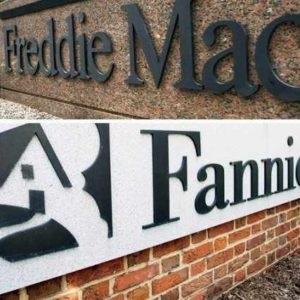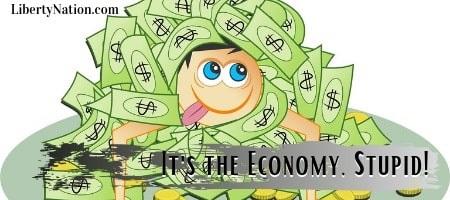Have Fannie And Freddie Learned Nothing?
Authored by Andrew Moran via LibertyNation.com,
Is the housing market about to crash? Some analysts find pockets of weakness in the real estate market as proof that the housing bubble 2.0 is about to pop. One of the biggest markets in the country, Los Angeles, has witnessed a 31% plunge in condominium sales in the third quarter. The sky is not falling because this incident has a reason: Buyers from Beijing accounted for half of condo acquisitions since 2014, and now Chinese cash is drying up. In New York City, a quarter of new luxury apartments are unsold and empty.
Those forecasting a contraction in housing next year may need to wait a little bit longer. New-home construction permits, housing starts, and the average price of single-family homes are all recording growth. When you consider the latest announcement from the federal government and the Federal Reserve artificially lowering interest rates, you can expect continued expansion and higher prices.
That is not to say that you should be worried about a 2007-style crash. For now, the bubble will balloon. When it pops, head for shelter.
Fannie And Freddie Feeling A Loan
The Federal Housing Finance Agency (FHFA) recently announced that it would raise the limit on conforming loans. This means that Fannie Mae and Freddie Mac will allow borrowers nationwide to take out mortgages totaling $510,400; it will top $765,000 in high-cost areas. The loan limits were raised higher in all but 43 counties across the United States.
Conforming loans are mortgages that adhere to the financing limits outlined by the FHFA and meet the underwriting guidelines laid out by Fannie and Freddie. This is the fourth straight year that the conforming loan limit has been raised; it was frozen at $417,000 between 2006 and 2016.
According to federal legislation, conforming loan limits are mandated to be modified to reflect adjustments in housing prices. Since FHFA data suggest home prices have jumped more than 5% in the 12 months to September 2019, the limits were increased by that much.
A White Picket Fence
Many industry experts celebrate the decision because it is expected to spur growth in the number of consumers seeking mortgages. However, before you pop open a bit of the bubbly, practice some caution.
Moving forward, mortgages will be greater, Fannie and Freddie will be scooping up larger loans. In the event of a market downturn or another housing crash, the U.S. government is once again threatening the solvency of the two agencies. Because Fannie and Freddie have returned to their 2006 ways, there is no reason to doubt that they will go belly-up and request a bailout again.
Since 2014, the mortgage agencies have slashed their down payment rates to just 3%. This encouraged the private sector to follow suit as many lenders, such as Wells Fargo and Michigan-based Flagstar Bank, have adopted the same figure. So, if you are taking out a $510,000 mortgage and are only asked to put down 3%, then you have very little skin in the game. At the same time, they account for roughly half of all new mortgages.
Former President Barack Obama compounded the problem as his administration ordered the Federal Housing Administration (FHA) to cut annual mortgage insurance premiums to 0.85%.
In February 2018, the Treasury Department transferred a $5.1 billion bailout to Fannie and Freddie. Because Congress forced these entities to reduce the amount of capital on their balance sheets and allocate a quarter of their reserves to the Treasury, their coffers were relatively empty.
Barrier To Entry
Home price growth has somewhat slowed in recent years, but many markets have still priced would-be homebuyers out of the market. Constant reports show the American dream of homeownership is a distant reality for millennials. Or, if you successfully slipped into the market, then you could be one of the 4.5 million households possessing an underwater mortgage. It might be a bull market, but it is bearish for many other Americans.
The current expectation is that the higher limits will create new demand, even if housing supplies are short in numerous parts of the nation. But if sellers can receive the best dollar for their homes and see bidders can get a $510,000 mortgage, then wouldn’t they lift the starting price? Bidding wars are not as fierce as they once were, but they still account for about 10% of all properties.
Officials might have the right intentions — helping Americans achieve homeownership — but this maneuver has more consequences than you could count on your fingers and toes.
Blowing Bubbles
The federal government has completely distorted the real estate market. A decade after the housing crash, politicians and bureaucrats still have not learned the economic lessons. Presidential candidates are shooting for policies that caused the bubble in the first place, and paper pushers are doubling down on measures that fueled the collapse.
Some correctly point out that the optics of higher loan limits are creating consternation among investors. At the same time, they argue that the government is facilitating the financial system’s origination of jumbo mortgages – a borrower who has good credit but exceeds the conforming limit. You can blame the Federal Reserve for this because its historically low interest rates enable this type of reckless borrowing and lending. Thanks to cheap money and government bailouts of banks and Fannie and Freddie, you would not have interventionist measures that produce such moral hazards.
Tyler Durden
Tue, 12/03/2019 – 13:55
via ZeroHedge News https://ift.tt/2DF8LJZ Tyler Durden


